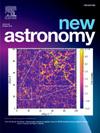Exploring the halo occupation distribution for moderate X-ray luminosity active galactic nuclei in the EAGLE cosmological simulation
IF 2.1
4区 物理与天体物理
Q2 ASTRONOMY & ASTROPHYSICS
引用次数: 0
Abstract
The hydrodynamical cosmological simulation EAGLE is used to model the Halo Occupation Distribution (HOD) of moderate X-ray luminosity active galactic nuclei (mXAGN), extending previous work using only dark matter simulations and empirical relations. By examining mergers as a triggering mechanism, we focus on halos typical of galaxy groups and cluster-like systems with masses . We analyze simulation data to create catalogs of central and satellite galaxies. We study their merger history we quantify the percentage of minor and major mergers in the mXAGN sample. We obtain the HOD for central and satellite mXAGN across a redshift interval from to the present epoch. Our results indicate that, across most redshifts, minor mergers slightly predominate as the primary mechanism for triggering mXAGN.
在EAGLE宇宙学模拟中探索中等x射线光度活动星系核的晕占比分布
利用流体动力学宇宙学模拟EAGLE对中等x射线亮度活动星系核(mXAGN)的晕晕分布(HOD)进行了建模,扩展了以往仅使用暗物质模拟和经验关系的工作。通过研究合并作为触发机制,我们重点研究了质量≥1012.75M⊙h−1的星系团和星系团系统的典型晕。我们分析模拟数据来创建中心星系和卫星星系的目录。我们研究了它们的合并历史,量化了mXAGN样本中次要和主要合并的百分比。我们获得了从z=2到当前历元的红移区间内中央和卫星mXAGN的HOD。我们的结果表明,在大多数红移中,次要合并作为触发mXAGN的主要机制略微占主导地位。
本文章由计算机程序翻译,如有差异,请以英文原文为准。
求助全文
约1分钟内获得全文
求助全文
来源期刊

New Astronomy
地学天文-天文与天体物理
CiteScore
4.00
自引率
10.00%
发文量
109
审稿时长
13.6 weeks
期刊介绍:
New Astronomy publishes articles in all fields of astronomy and astrophysics, with a particular focus on computational astronomy: mathematical and astronomy techniques and methodology, simulations, modelling and numerical results and computational techniques in instrumentation.
New Astronomy includes full length research articles and review articles. The journal covers solar, stellar, galactic and extragalactic astronomy and astrophysics. It reports on original research in all wavelength bands, ranging from radio to gamma-ray.
 求助内容:
求助内容: 应助结果提醒方式:
应助结果提醒方式:


